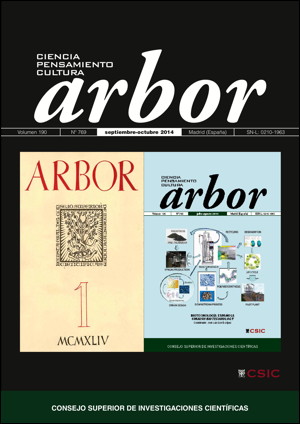Reflections on fear in the 21st century: philosophy, politics, genetics and evolution
DOI:
https://doi.org/10.3989/arbor.2014.769n5011Keywords:
Fear, genetics, evolution, heuristic, hermeneuticsAbstract
Recent events and those of past decades highlight the role of fear in public life. The fear and its causes are present in the mass media, political discourse, neuroscience, science and political philosophy. We take the view that intuitive, cognitive and heuristic fear management needs to be considered a basic feature of citizens’ lives in the current century. In both the modern vision of the nation and in the social contract, as well as in the most futuristic visions of cosmopolitanism and supranational states, the heuristic of fear will not disappear, not just because its intrinsic utility, but also its immanence at the genetic-biological and psycho-social level. We believe that the existence of fear is positive, as it alerts us to risks that may have a negative impact on the individual’s future.
Downloads
References
Ayala, F. J. y Kiger, J. A. (1984). Modern Genetics (2nded.). Benjamin-Cummings Publishing Co.
Benito, C. y Espino, F. J. (2012). Genética. Conceptos esenciales. Madrid: Médica Panamericana.
Blanchard, D. C. y Blanchard, R. J. (1988). Ethoexperimental approaches to the biology of emotions. Annual Review of Psychology, 39, pp. 43-68. http://dx.doi.org/10.1146/annurev.ps.39.020188.000355
Bolles, R. C. (1970). Species-specific defense reactions and avoidance learning. Psychological Review, 77, pp. 32-48. http://dx.doi.org/10.1037/h0028589
Bourke, J. (2005). Fear: a cultural history. London: Virago Press.
Bracha, H. S. (2006).Human brain evolution and the 'Neuroevolutionarytime-depth principle'. Implications for the reclassification of fear-circuitry-related traits in DSM-V and for studying resilience to warzone-related posttraumatic stress disorder. Progress in Neuro-Psychopharmacology and Biological Psychiatry, 30, pp. 827-853. http://dx.doi.org/10.1016/j.pnpbp.2006.01.008
Bracha, H. S., Yoshioka, D. T., Masukawa, N. K. y Stockman, D. J. J. (2005). Evolution of the human fear-circuitry and acute sociogenic pseudoneurological symptoms: the Neolithic balanced-polymorphism hypothesis. Journal of Affective Disorders, 88, pp. 119-129. http://dx.doi.org/10.1016/j.jad.2005.05.013
Cano, M. y Vives-Rego, J.(2013). El ciudadano ecológico en los procesos de decisión social de la sostenibilidad: tecnociencia, ecoética y cosmovisión. Sociología y Tecnociencia, 4, pp. 38-57.
Fromm, E. (2005). El miedo a la libertad. Barcelona: Paidós.
Gauthier, D. (1969). The logic of Leviathan. Oxford: Oxford University Press.
Gordon, R. (1987). The structure of the emotion. Cambridge: Cambridge University Press.
Griffiths, A. J. F., Wessier, S. R., Lewontin, R. C. y Carroll, S. B. (2008). Genética (9ª ed). Madrid: Mc Graw Hill.
Hansberg, O. (1996). La diversidad de las emociones. México D.F.: Fondo de Cultura Económica.
Hettema, J. M. y Kendler, K. S. (2003). A twin study of the genetics of fear conditioning. Archives of General Psychiatry, 60, pp. 702-708. http://dx.doi.org/10.1001/archpsyc.60.7.702
Innerarity, D., y Solana, J. (2011). La humanidad amenazada: gobernar los riesgos globales. Barcelona: Paidós.
Jonas, H. (2004). El principio de la responsabilidad. Barcelona: Herder Editorial.
Klug, W. S., Cummings, M. R. y Spencer, C. A. (2006). Conceptos de Genética (8ª ed.). Madrid: Pearson – Prentice Hall.
Lacleau, E. y Mouffe, C. (1985). Hegemony and socialist strategy: towards a democratic radical democracy politics. London: Verso Books.
LeDoux, J. (1998). Fear and the brain: where have we been, and where are we going? Biological Psychiatry, 44, pp. 1229-1238. http://dx.doi.org/10.1016/S0006-3223(98)00282-0 http://dx.doi.org/10.1016/S0006-3223(98)00282-0
Mauthner, F. (2001). Contribuciones a una crítica del lenguaje. Barcelona: Herder.
Mineka, S. (1979).The role of fear in theories of avoidance learning, flooding and extinction. Psychological Bulletin, 86, pp. 985-1010. http://dx.doi.org/10.1037/0033-2909.86.5.985
Mineka, S. y Öhman, A. (2002). Phobias and preparedness: the selective, automatic, and encapsulated nature of fear. Biological Psychiatry, 52, pp. 927-937. http://dx.doi.org/10.1016/S0006-3223(02)01669-4
Mouffe, C. (1993). The return of the political. London: Verso Books.
Mouffe, C. (2000). The democratic paradox. London: Verso Books.
Nesse, R. M. (1990). Evolutionary explanations of emotions. Human Nature, 1, pp. 261-289. http://dx.doi.org/10.1007/BF02733986
Neufeld, J. (1991). Japan in flames. En: Nalty, B. C. (ed.). War in the Pacific. Pearl Harbor to Tokyo Bay. London, Salamander Books, pp. 268-283.
Olsson, A. y Phelps, E. A. (2007). Social learning of fear. Nature Neuroscience, 10, pp. 1095-1102. http://dx.doi.org/10.1038/nn1968
Panksepp, J. (1998). Affective Neuroscience: the foundation of human and animal emotions. New York: Oxford University Press.
Russell, P.A. (1979). Fear-evoking stimuli. En: Sluckin, W. (ed.). Fear in animals and man. New York: Van Nostrand Reinhold, pp. 85-124.
Sklahr, J. (1989). The liberalism of fear. En: Rosenblum, N. (ed.). Liberalism and the Moral Life. Harvard: Harvard University Press.
Strachan, T., y Read, A. P. (2010). Human molecular genetics (4thed.). New York: Garland Science Publishing.
Van Le, Q., Isbell, L. A., Matsumoto, J., Nguyen, M., Hori, E., Mayor, R. S., Tomaz, C., Than, A. H., Ono, T. y Nishijo, H. (2013). Pulvinar neurons reveal neurobiological evidence of past selection for rapid detection of snakes. Proceedings of the National Academy of Sciences, 110, pp. 19000-19005. http://dx.doi.org/10.1073/pnas.1312648110
Vives-Rego, J. (2010). Los dilemas medioambientales del siglo XXI ante la ecoética. Madrid: Bubok.
Vives-Rego, J. (2011). ¿Suicidio político o suicidio ecológico? Madrid: Fundamentos.
Vives-Rego, J. (2013). El ciudadano ecológico: reflexiones sobre algunos contextos sociales y elementos cosmovisionales. Sociología y Tecnociencia, 3, pp. 83-104.
Wanty. E. (1972). L'art de la guerre. Bruselas: Gerard and Co.
Zentner, J. (1969). Die Kriege der Nachkriegszeit. München: Su.dwestVerlag.
Zolo, D. (2009). Terrorismo umanitario. Dalla guerra del Golfo alla strage di Gaza. Reggio Emilia: Diabasis.
Published
How to Cite
Issue
Section
License
Copyright (c) 2014 Consejo Superior de Investigaciones Científicas (CSIC)

This work is licensed under a Creative Commons Attribution 4.0 International License.
© CSIC. Manuscripts published in both the printed and online versions of this Journal are the property of Consejo Superior de Investigaciones Científicas, and quoting this source is a requirement for any partial or full reproduction.
All contents of this electronic edition, except where otherwise noted, are distributed under a “Creative Commons Attribution 4.0 International” (CC BY 4.0) License. You may read the basic information and the legal text of the license. The indication of the CC BY 4.0 License must be expressly stated in this way when necessary.
Self-archiving in repositories, personal webpages or similar, of any version other than the published by the Editor, is not allowed.














